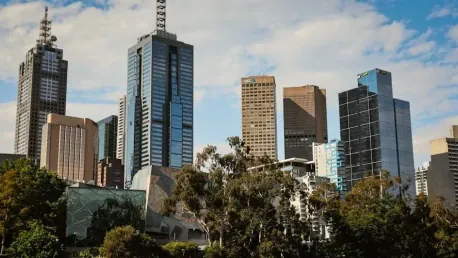Melbourne’s outer-suburban greenfield land development is currently facing significant challenges linked to the disconnection between its planned infrastructure and the actual progress of development. This pressing issue can be vividly illustrated through the experience of Sameer Sharma, a resident of the Cloverton estate. When Sharma moved to Cloverton, he was enticed by promises of proximity to essential infrastructure such as a train station, schools, and a freeway interchange. These assurances, prominently marketed on the developer’s billboard, were based on the 2012 Lockerbie precinct structure plan (PSP) ratified by the state government. However, twelve years have passed, and the reality lags far behind the promises, with many services unbuilt or remaining unconfirmed.
The Reality of Unmet Promises
Sameer Sharma’s daily commute to Melbourne’s central business district (CBD) is a testament to the broader issues that residents of Melbourne’s outer suburbs face daily. Traveling on the Seymour line, Sharma endures infrequent and overcrowded trains from Donnybrook station. The station offers a mere four trains to the city during the two-hour peak period from 7 am to 9 am, and an hourly service during off-peak times. Such inadequate train services highlight the severe lag in infrastructure development compared to the rapid population growth these suburban regions are experiencing. This discrepancy between planned developments and present realities is a pattern seen across Melbourne’s greenfields.
In response to the mounting frustrations of residents like Sharma, the state government has recently released a 10-year plan aimed at addressing some of these concerns by targeting the development of 180,000 homes in Melbourne’s fringe suburbs. These areas include Melton, Sunbury, Mambourin, Wallan, Clyde, and Cardinia, focusing on utilizing the remaining 27 undeveloped PSPs. However, despite the ambitious scope of this plan, there has been a noticeable slowdown in PSP approvals, with the last approval granted nearly three years ago in March 2022. Additionally, the plan has postponed potential new estate projects in Wallan by several years, further delaying residents’ access to much-needed infrastructure.
Government’s 10-Year Plan and Its Implications
Planning experts and property sector analysts offer critical insights into the root causes behind the lagging infrastructure. They suggest that the government’s deliberate slowdown in approving new developments in greenfield areas stems from an inability to fund the necessary infrastructure at a pace that matches population growth. This bottleneck could potentially inflate property prices in Melbourne’s suburbs, drawing alarming parallels with Sydney’s housing market, where growth area median house prices have skyrocketed. As a result, the lack of timely PSP approvals risks replicating some of the challenges seen in Sydney’s housing crisis.
According to Oliver Hume, a property services group, Melbourne might face similar challenges to Sydney if the current pace of land releases does not improve. Presently, median house prices in Sydney’s growth areas approximate $1.1 million, reflecting a staggering 77% premium compared to Melbourne’s $672,000—a situation attributed largely to restricted land supply. Both planning experts and property sector insiders agree that the state government’s strategies might be driven by dual aims: redirecting growth into already established areas to meet the goal of placing 70% of housing in these regions, and acknowledging the challenge of catching up with the infrastructure demands in fast-growing suburban communities.
The Risk of Replicating Sydney’s Housing Market Crisis
Andrew Butt, a professor in sustainability and urban planning at RMIT University, echoes the concerns raised by both planning experts and sector analysts. He contends that the government’s current strategies reflect an attempt to balance the need for sustainable development with the fiscal realities of funding infrastructure at a pace that keeps up with rapid suburban growth. His view, backed by unnamed planning insiders, suggests that investments in these burgeoning communities are evaluated against their substantial costs, often deemed too substantial to proceed as quickly as required.
However, implementing such a strategic slowdown could inadvertently push Melbourne towards a housing market crisis similar to Sydney’s. As median house prices in Sydney’s growth areas soar beyond Melbourne’s, Melbourne residents could face limited options for affordable living. Over time, this could drive homebuyers towards unaffordable inner-city apartments rather than the more cost-effective homes they desire on the suburban fringe. This scenario underscores the necessity for re-evaluating the current strategy, advocating for accelerated infrastructure development in greenfields to accommodate the growing population more effectively.
Balancing Development and Infrastructure
The government’s newly released 10-year plan for greenfield development includes revisiting existing precincts to examine higher density housing solutions. This addition presents a crucial timing dilemma: is it better to proceed with standard density developments without adequate infrastructure now or to wait and provide improved infrastructure for higher-density developments in the future? The chosen approach will significantly impact how quickly the remaining undeveloped greenfield land is utilized and how future development shapes up.
Julian Coppini, the CEO of Oliver Hume, has been an outspoken critic of the government’s stance, arguing that it limits homebuyers’ choices and forces many towards the increasingly unaffordable inner-city housing market. Coppini’s criticism adds to the growing concerns that Melbourne could soon face a housing market crisis like Sydney’s if the land supply for new homes continues to be constrained. He emphasizes the necessity for a more accelerated land release strategy to maintain affordability and meet the housing demands of Melbourne’s expanding population.
The Broader Urban Planning Challenges
Melbourne’s outer-suburban greenfield land development is grappling with major hurdles due to a significant disconnect between the planned infrastructure and the actual development progress. This issue is starkly highlighted by the experience of Sameer Sharma, a resident of the Cloverton estate. Sharma decided to move to Cloverton based on enticing promises of nearby infrastructure, including a train station, schools, and a freeway interchange. These amenities were prominently advertised on the developer’s billboard and rooted in the 2012 Lockerbie precinct structure plan (PSP) approved by the state government. However, twelve years later, the reality remains woefully behind these promises. Many of the expected services remain either unbuilt or unconfirmed. This situation underscores the frustration of many residents who feel misled by promotional material that promised much but delivered little, causing issues for families and commuters who depend on these planned infrastructures for daily living and convenience.









